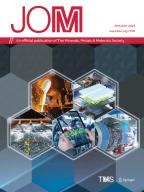Abstract
Bismuth, the most metallic element in group V A of the periodic table, is primarily a by-product of lead refining. It is also a by-product of several ore-dressing operations, especially high-grade scheelite and wolframite ores. It is generally recovered by processing lead electrorefining slimes, Kroll-Betterton dross, and other process residues which contain bismuth. No matter the source, it is refined to virgin metal with chlorine. Bismuth’s unique properties make it attractive for a plethora of applications such as alloying additives in steel and aluminum, fusible alloys, and pharmaceuticals. Recent awareness of the “green” nature of bismuth in free-machining steels and similar applications has made it a potential substitute for metals deemed less favorable environmentally.
Similar content being viewed by others
References
R.B. Gordon and J.R. Rutledge, “Bismuth Bronze from Machu Picchu, Peru,” Science, 223 (1984), pp. 585–586.
H. Remy, Treatise On Inorganic Chemistry (New York: Elsevier, 1956) p. 675.
K.C. Li and C.Y. Wang. Tungsten (New York: Reinhold, 1955), pp. 41–42, 46-47, 116.
K. Moriya, “Lead Smelting and Refining—Its Current Status and Future,” Lead-Zinc’ 90, ed. T.S. Mackey and R.D. Prengaman (Warrendale, PA: TMS, 1990), pp. 23–38.
A.D. Betts, Lead Refining By Electrolysis (New York: John Wiley & Sons, 1908).
I.L. Barker, “Slimes Treatment and Silver Refining Operations by the Cerro De Pasco Corporation at La Oroya, Peru,” Silver- Economics, Metallurgy and Use, ed. A. Butts and C.D. Coxe (New York: Van Nostrand, 1967), ch. 6.
J.D. Betterton and Y.E. Lebedelf, “Debismuthizing Lead with Alkaline Earth Metals, Including Magnesium, and with Antimony,” Trans. AIME, 21 (1936), pp. 205–225.
Anon., Mineral Commodity Summaries 1991 (Washington, D.C: U.S. Bureau of Mines, 1991), pp. 26-27.
S.M. Jasinski, “Bismuth” (U.S. Bureau of Mines Yearbook, 1988); see also Mineral Industry Surveys, Bismuth in the Third Quarter, 1990.
Z. Wenpu et al., “A Bismuth-Containing Pigment: Molybdenum-Tungsten Yellow,” Bull. of the Bismuth Institute, 56 (1989), pp. 7–9.
H. Pray, R.S. Peoples, and F. W. Fink, “Addition of Bismuth for Producing Free-machining Stainless Steels,” Proc. ASTM, 41 (1941), pp. 646–675.
“About Bismuth in INcut 200: A new series of Free-machining Steels,” Bull. of the Bismuth Institute 46 (1985), pp. 1-6.
Tabulated data are compiled from: H.H. Howe, “Bismuth,” Rare Metals Handbook, ed. C.A. Hampel (London: Reinhold, 1961), and S.P. Parker, ed., McCraw-Hill Concise Encyclopedia of Science and Technology (1984), p. 233.
Metals Handbook, 9th ed., vol. 3 (Materials Park,OH: ASM, 1980), pp. 799–801.
Author information
Authors and Affiliations
Rights and permissions
About this article
Cite this article
Ojebuoboh, F.K. Bismuth—Production, properties, and applications. JOM 44, 46–49 (1992). https://doi.org/10.1007/BF03222821
Issue Date:
DOI: https://doi.org/10.1007/BF03222821
